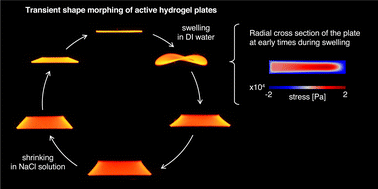Transient shape morphing of active gel plates: geometry and physics†
Abstract
The control of shape in active structures is a key problem for the realization of smart sensors and actuators, which often draw inspiration from natural systems. In this context, slender structures, such as thin plates, have been studied as a relevant example of shape morphing systems where curvature is generated by in-plane incompatibilities. In particular, in hydrogel plates these incompatibilities can be programmed at fabrication time, such that a target configuration is attained at equilibrium upon swelling or shrinking. While these aspects have been examined in detail, understanding the transient morphing of such active structures deserves further investigation. In this study, we develop a geometrical model for the transient shaping of thin hydrogel plates by extending the theory of non-Euclidean plates. We validate the proposed model using experiments on gel samples that are programmed to reach axisymmetric equilibrium shapes. Interestingly, our experiments show the emergence of non-axisymmetric shapes for early times, as a consequence of boundary layer effects induced by solvent transport. We rationalize these observations using numerical simulations based on a detailed poroelastic model. Overall, this work highlights the limitations of purely geometrical models and the importance of transient, reduced theories for morphing plates that account for the coupled physics driving the evolution of shape. Computational approaches employing these theories will allow to achieve accurate control on the morphing dynamics and ultimately advance 4D printing technologies.



 Please wait while we load your content...
Please wait while we load your content...